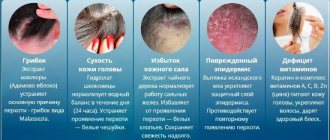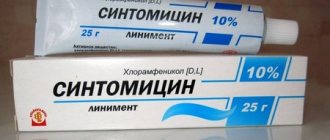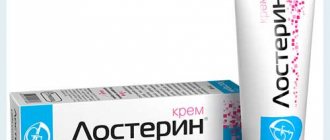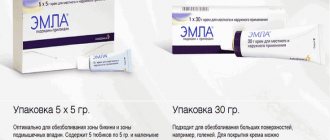Vishnevsky ointment is a universal drug that has a wide range of applications. For example, it cleanses a woman’s internal genital organs, heals wounds and minor injuries, resolves cysts, restores damaged tissue after surgery, eliminates obstruction of the fallopian tubes, helps restore natural microflora, and has antimicrobial and antifungal properties. That is why it is justified to use Vishnevsky ointment for bartholinitis.
In the field of medicine for women, this remedy is used before and after surgical interventions for faster healing, as well as as part of complex therapy. Reviews from many patients claim that Vishnevsky ointment for bartholinitis really has a healing effect.
Do not neglect such well-known remedies as ichthyol ointment for bartholinitis: compresses are made on their basis. If you immediately start treatment at home at the first symptoms, then after 2-3 days you can get your health in order without resorting to surgical intervention. But with one caveat - if the lesion does not reach large sizes.
What is Dimexide used for?
The drug is prescribed for problems with the functioning of the musculoskeletal system. In addition, in case of subcutaneous damage to soft tissues, Dimexide actively relieves the inflammatory process. The ability of the drug to enhance the effect of other drugs is often used by doctors in antibacterial therapy. Direct indications for prescribing Dimexide are:
- bursitis;
- arthrosis;
- arthritis;
- radiculitis;
- gout;
- osteochondrosis;
- pain syndrome due to intervertebral hernia;
- scleroderma;
- skin ulcers;
- swelling accompanied by pain;
- synovitis
In addition to the above problems, Dimexide is also used in other areas, including cosmetology.
Vishnevsky ointment or Levomekol - which is better and more effective
Manufacturer: NIZHFARM (Russia)
Release form: ointment
Active ingredient: chloramphenicol, methyluracil
Both drugs have equivalent indications and results in the treatment of purulent wounds.
Levomekol will be effective in the acute period, when there is an inflammatory process, but there is no pus. This analogue copes well with inflammation due to ingrown toenails.
When an abscess forms that does not reach the surface of the skin (furuncle, panaritium), it would be rational to use Vishnevsky ointment in the form of a compress to stimulate its formation. In the area of influence of the medicine, blood flow occurs and the “maturation” of the abscess accelerates.
After drainage of the cavity and discharge of pus, it is better to continue treatment with Levomekol, which actively suppresses pathogenic microflora and stimulates the healing of the damaged skin area.
How to dilute Dimexide for hair
As a result of the fact that Dimexide was seen as a kind of catalyst for some local drugs, which quickly penetrated the cellular barrier deep into the tissues, Dimexide began to be used as part of cosmetic masks.
In particular, by mixing a teaspoon of the substance concentrate with essential oils, lemon juice, aloe extract and honey, you get an effective hair mask. Its regular use relieves hair from brittleness, gives rich shine and restores natural growth. And if you mix a teaspoon of Dimexide with ground red pepper and apply it to the scalp, holding for 15 minutes, you can wake up dormant bulbs, resulting in thicker curls.
Composition and action of the ointment
The effectiveness, which was very soon highly appreciated by doctors and patients, follows from the description of Vishnevsky’s ointment. The product includes
- birch tar,
- xeroform (organic bismuth salt),
- castor oil.
- Birch tar, obtained by dry distillation of birch wood, contains resins and a number of organic unsaturated compounds that have a benzene ring in their structure, such as benzene, phenol, xylene, etc.
Many of these compounds are also antiseptics, that is, anti-putrefactive substances that prevent decomposition processes in damaged tissues and inhibit the proliferation of microorganisms. In addition, they give the ointment an irritating effect.
Xeroform, due to the bismuth it contains, has an astringent, drying effect. Xeroform is also an antiseptic.
- The specific unpleasant odor of liniment according to Vishnevsky is a mixture of the odors of birch tar and xeroform.
Castor oil in the ointment is a formative substance, which is why the ointment turns out liquid, that is, it is more correct to call it liniment. Vegetable castor oil is isolated from castor bean seeds. It does not dry out and does not form a film, which is why it is used in the preparation of liniments.
Summarizing this information, it is easy to see what the therapeutic effect of Vishnevsky ointment is. It has antiseptic, antibacterial, irritating, drying and astringent effects. The sum of these actions gives the ointment wound-healing and stimulating tissue regeneration (renewal, restoration) effects.
Application of ointment
- Why is Vishnevsky ointment used now, when the range of local wound-healing drugs is very wide?
- This remedy is indicated for use in the treatment
- inflammatory and purulent-inflammatory processes on the skin (boils, carbuncles, abscesses),
- burns and frostbite,
- trophic ulcerative skin lesions (for example, bedsores),
- hemorrhoids.
These indications are indicated in the instructions for use attached to each tube of Vishnevsky ointment. Other recommendations circulating on the Internet should be treated critically, remembering that with an abundance of medicines, this somewhat outdated drug is left in production only for use in cases where its undoubted effectiveness is known.
In addition, it has been revealed that long-term uncontrolled use of this ointment increases the risk of developing skin cancer.
About the features of use
- To treat skin lesions, soak a sterile napkin of a suitable area with ointment, apply it to the lesion, cover it with another dry napkin, and secure it with a bandage.
- When performing dressings, surgeons sometimes soak turundas (also a type of sterile napkins) with ointment and place the latter into the wound cavity.
To treat inflamed hemorrhoids, also apply a napkin soaked in ointment to the affected area, not forgetting to first wash it with a weak solution of potassium permanganate. They try to keep the napkin in place for about three hours, then it needs to be changed.
Here, perhaps, are all the main features of using Vishnevsky ointment.
Alternative Medicines
Once upon a time there was no replacement for this liniment.
Now there is a choice. The best analogues of Vishnevsky ointment are:
- Levomekol
- Nitacid
- Streptoplaven
- Panthenol
- Bepanten
- Solcoseryl
All these medications are available in forms for external use. Not all of them have equally pronounced antimicrobial and wound-healing effects. Not all are available in pharmacies without a prescription. In any case, medical advice should be obtained before using them.
Photo of Vishnevsky ointment
- We also recommend:
Read here: Ultrasound scanner for cattle - effective veterinary equipment
How to dilute Dimexide for boils
Inflammation of the skin glands, which develop into boils, is often accompanied by a local increase in temperature and tension on the skin surface. In order to relieve pain and reduce tissue tension due to growing inflammation, dilute Dimexide in warm water in the proportion of 1 ml of concentrate per 10 ml of clean water. Cotton pads are soaked in the resulting solution and applied to the boils. It is important not to rub, rub, or knead an unruptured boil. Safe use is considered to be simply applying a moistened swab to the inflamed area.
Vishnevsky ointment: analogues, what helps? — Website about the treatment of varicose veins
Vishnevsky ointment was created during the war years and has continued to be popular since then. It helps restore tissue, relieve the purulent process and has anti-inflammatory, wound-healing properties.
It is used everywhere and helps in seemingly hopeless cases. Many people do not like the ointment because of the very unpleasant smell, but you should overcome yourself, since this particular remedy can get rid of many problems.
Suppuration resolves in just a few days, and in case of inflammation of the skin and other organs, the ointment has saved thousands of people from operations.
Composition of the product and release form
The composition of the ointment is quite simple, it includes:
- Xeroform;
- Birch tar;
- Castor oil.
Birch tar helps improve nutrition and blood circulation in tissues, xeroform is an antiseptic, and castor oil helps the ingredients penetrate the skin and restore its structure. Since all the ingredients are natural, the product is completely safe to use.
Vishnevsky ointment is available in dark glass jars of 50-100 g. It has a rather thick consistency and a specific smell. It is difficult to confuse this ointment with any other.
The smell comes from xeroform and tar, so not everyone likes it. However, despite this, the product is extremely effective. Therefore, anyone who has ever encountered panaritium knows this.
How to dilute Dimexide for heel spurs
The situation with inflammation of the heel, called a heel spur, can be resolved not only through surgery. In some situations, a conservative method using Dimexide may help. It is important to begin treatment at the first signs of inflammation in order to prevent the disease from entering an irreversible phase when the help of a surgeon is required. For spurs, use a concentration of Dimexide diluted in water in a one to one ratio. Taking 20 ml of the drug you need to add 20 ml of water.
For severe pain, novocaine 2% is added to the solution in a volume equal to the amount of Dimexide and water. A cloth is moistened in the resulting liquid and placed on the sore spot. The compress is covered with polyethylene and a wool sock is put on.
Dimexide for sinusitis
Sinusitis is an inflammation of the maxillary sinuses, accompanied by an accumulation of mucus pressing on the nasal cartilage from the inside. The disease may be accompanied by redness of the skin over the sinuses, as well as an increase in temperature, which is localized in the area of the inflammatory process. Dimexide will help relieve swelling of the mucous membranes and reduce inflammation in the nasal passages. It is mixed with saline solution in a ratio of 1:3.
You can also add aloe juice or vasoconstrictor nasal drops, for example, naphthyzine or phenylephrine. After moistening cotton swabs in the resulting solution, they are inserted into each nasal passage and kept in this position for up to 20 minutes. This treatment can be repeated for up to 7 days in a row.
Indications for use of Vishnevsky ointment
The drug is prescribed for external use in the following processes:
- purulent-inflammatory processes of the skin (carbuncles, boils, phlegmon, abscesses);
- infected wounds of a purulent nature;
- trophic ulcers of various origins (diabetes mellitus, varicose veins);
- osteomyelitis;
- burns, bedsores, frostbite;
- psoriasis;
- obliterating endarteritis.
This medication is used as a remedy for subcutaneous acne, for the treatment of external hemorrhoids, and nonspecific diseases of the female genitalia (syphilis).
Adverse reactions
The use of Dimexide, like any other drug, can lead to unpleasant side reactions. Among them:
- redness of skin areas;
- burning in the area of application;
- allergic reactions, manifested by nasal congestion, drainage from the eyes, bronchospasm and rhinitis;
- skin pigmentation;
- nausea;
- muscle weakness;
- dizziness;
At the first signs of illness as a result of using Dimexide, you should definitely stop therapy and discuss what happened with your doctor.
Balsamic liniment (according to Vishnevsky) analogues and prices
Description Hard gelatin capsules of yellow color No. 0, cylindrical in shape with hemispherical ends. Composition one capsule contains: Active substances: Lipoid C 100 in terms of phosphatidylcholine - 50.0 mg, milk thistle fruit extract dry in terms of silymarin - 45.0 mg, dry vitamin E-acetate 50% DC in terms of α-tocopheryl acetate - 30.0 mg, selenomethionine, premix 0.5% in terms of selenium - 0.012 mg. Excipients: calcium stearate, collidon 30 (povidone), colloidal anhydrous silicon dioxide (Aerosil-300), maltodextrin, calcium hydrogen phosphate dihydrate.
Composition of the gelatin capsule shell: Gelatin, titanium dioxide E171, quinoline yellow E104, azorubine E122, crimson 4R E124, purified water.
Capsule form Pharmacotherapeutic group Combined drug for the treatment of liver diseases.
Pharmacological properties Combined drug. It has a membrane-stabilizing, hepatoprotective, antioxidant effect. Phosphatidylcholine is a structural element of cellular and intracellular membranes, capable of restoring their structure and function when damaged, providing a cytoprotective effect. Normalizes protein and lipid metabolism, prevents the loss of enzymes and other active substances by hepatocytes, restores the detoxifying function of the liver, inhibits the formation of connective tissue, reducing the risk of fibrosis and cirrhosis of the liver. Silymarin has a hepatoprotective effect due to competitive interaction with receptors for the corresponding toxins in the hepatocyte membrane, thus exhibiting a membrane-stabilizing effect, stimulates the synthesis of proteins (structural and functional) and phospholipids in damaged hepatocytes, thus accelerating regenerative processes. The effect of flavonoids, which include silymarin, is also determined by their antioxidant properties and effects that improve microcirculation. Vitamin E is involved in the processes of cell proliferation, tissue metabolism, prevents hemolysis of red blood cells, and prevents increased permeability and fragility of capillaries. The drug inhibits free radical reactions, prevents the formation of peroxides that damage cellular and subcellular membranes. Improves tissue respiration, stimulates protein synthesis (collagen, enzymatic, structural and contractile proteins of skeletal and smooth muscles, myocardium), protects vitamin A from oxidation, inhibits cholesterol synthesis. Inhibits the oxidation of unsaturated fatty acids and selenium (a component of the microsomal electron transfer system). Selenium is one of the essential microelements that plays an important role in the normal functioning of vital organs and systems. Selenium has a protective effect in acute and chronic intoxication with xenobiotics. Selenium is an effective antioxidant at the cellular level.
Indications for use The drug is used in the complex treatment of chronic toxic liver damage; for maintenance treatment in patients with chronic inflammatory liver diseases or cirrhosis, for the symptomatic elimination of loss of appetite and/or heaviness in the right hypochondrium in the following liver diseases: fatty liver degeneration (also in diabetes); hepatitis of any nature, acute and chronic; cirrhosis; toxic liver damage, drug-induced liver damage; alcoholic liver disease, cholestasis.
Contraindications Hypersensitivity to the components of the drug, children under 12 years of age (lack of sufficient evidence base). Warnings and special instructions Do not exceed the recommended doses of the drug. Treatment with the drug cannot replace a diet or giving up anything in case of liver damage (for example, alcohol). Use with caution in patients with hormonal disorders (endometriosis, uterine fibroids, breast, ovarian and uterine carcinoma, prostate carcinoma) due to the possible estrogen-like effect of silymarin. If allergic reactions occur, treatment with the drug should be discontinued. Use during pregnancy or lactation It is not recommended to use the drug during pregnancy and lactation. Method of administration and dosage Standard treatment regimen for children over 12 years of age and adults: initial dose - 3 times a day, 2 capsules for at least 3 months, maintenance dose - 3 times a day, one capsule for at least 4 weeks. Take capsules during meals, without chewing, with a small amount of water. The attending physician may recommend a different dosage and duration of treatment, depending on the patient’s condition and the course of the disease.
Side effects The drug is well tolerated. The following side effects can rarely be observed: From the gastrointestinal system: nausea, dyspepsia, diarrhea. On the part of the skin and skin appendages: in some cases, allergic skin reactions are possible - itching, rash. Others: It is rare to see an exacerbation of existing vestibular disorders. Side effects are transient and disappear after stopping the drug.
Overdose There is no evidence of drug overdose. In case of accidental ingestion of a high dose, induce vomiting, perform gastric lavage using activated charcoal and symptomatic treatment if necessary. Interactions with drugs and other types of interactions Interactions with other drugs due to the presence of silymarin: When silymarin is used together with oral contraceptives and drugs for hormone replacement treatment, the effect of the latter may be reduced. Silymarin can enhance the effect of drugs such as diazepam, alprazolam, ketoconazole, lovastatin, vinblastine due to its inhibitory effect on the cytochrome P 450 system. Interactions with other drugs due to the presence of vitamin E: Increases the effectiveness of anticonvulsants in patients with epilepsy in whom An increased content of lipid peroxidation products in the blood was detected. Enhances the effect of steroidal and non-steroidal anti-inflammatory drugs and antioxidants. Increases the effectiveness and reduces the toxicity of cardiac glycosides, as well as vitamins A and D. Cholestyramine, colestipol, and mineral oils reduce the absorption of alpha tocopheryl acetate. High doses of iron enhance oxidative processes in the body, which increases the need for vitamin E. With the simultaneous use of alpha tocopheryl acetate with cyclosporine, the absorption of the latter increases.
Impact on the ability to drive a car, work with equipment . No effect.
Pack of 10 capsules in a blister pack. 3 or 6 blister packs in a cardboard pack.
Storage conditions : protected from moisture and light at a temperature not exceeding 25°C. Keep out of the reach of children.
Shelf life: 2 years. Do not use after the expiration date stated on the packaging.











